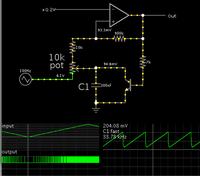steve_rb
Full Member level 3
Attached circuit is a Voltage to frequency converter. Input is pin 5 (0-10 V) and out put is pin 9 (500HZ-40000HZ). When pin 5 is connected to the ground I have 500 HZ at the output. I tried to decrease this to below 200 HZ using R13 potentiometer but it has no effect on point "A" and so on the output at all. It only changes voltage at point "B" but no change at the voltage of point "A". That is why I couldn't decrease the output frequency below 500 HZ so far. I put a few days on this but couldn't do this. Any advice what am I missing here? Parts are checked and there is no problem with the parts.
I need a detailed explanation on how this circuit is working to be able to decrease the output to below 200 HZ for zero input.
I need a detailed explanation on how this circuit is working to be able to decrease the output to below 200 HZ for zero input.
Attachments
Last edited:

